List of National Historic Sites of Canada in British Columbia
This is a list of National Historic Sites (French: Lieux historiques nationaux) in the province of British Columbia. As of January 2020, there were 100 National Historic Sites designated in British Columbia, 13 of which are administered by Parks Canada (identified below by the beaver icon ![]() ).[1][2] The first National Historic Sites to be designated in British Columbia were Fort Langley and Yuquot in 1923.
).[1][2] The first National Historic Sites to be designated in British Columbia were Fort Langley and Yuquot in 1923.
Numerous National Historic Events also occurred across B.C., and are identified at places associated with them, using the same style of federal plaque which marks National Historic Sites. Several National Historic Persons are commemorated throughout the province in the same way. The markers do not indicate which designation—a Site, Event, or Person—a subject has been given. The Rideau Canal is a Site, for example, while the Welland Canal is designated an Event. The cairn and plaque to John Macdonell does not refer to a National Historic Person, but is erected because his home, Glengarry House, is a National Historic Site.[3][4] Similarly, the plaque to John Guy officially marks not a Person, but an Event—the Landing of John Guy.[5]
This list uses names designated by the Historic Sites and Monuments Board of Canada, which may differ from other names for these sites.
National Historic Sites
| Site[1] | Date(s) | Designated | Location | Description | Image |
|---|---|---|---|---|---|
| 223 Robert Street[6] | 1905 (completed) | 1990 | Victoria 48°25′45.22″N 123°23′19.92″W |
A good example of the Queen Anne Revival Style in domestic architecture. |  |
| Abbotsford Sikh Temple[7] | 1912 (completed) | 2002 | Abbotsford 49°3′2.91″N 122°18′27.11″W |
The oldest surviving Sikh temple in Canada; the Temple played an important role in the first phase of Sikh immigration to Canada, and represents an adaptation of Sikh religious traditions to Canadian architectural norms of the early 20th century | 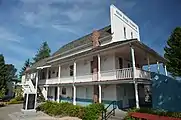 |
| Barkerville[8] | 1862 (founded) | 1924 | Barkerville 53°3′57″N 121°31′2″W |
The epicentre of the Cariboo Gold Rush, the catalyst for the economic and political development of British Columbia; the town was eventually abandoned and became a ghost town, but restoration commenced in 1958 |  |
| Bay Street Drill Hall[9] | 1915 (completed) | 1989 | Victoria 48°26′6.75″N 123°21′50.16″W |
A two-storey drill hall with Tudor Revival elements, built during the 1896 to 1918 period when over 100 drill halls and armouries were erected across Canada; its scale reflects the dramatic increase in military participation following Canada's performance during the Second Boer War |  |
| Begbie Hall[10] | 1926 (completed) | 1989 | Victoria 48°25′55.99″N 123°19′36.06″W |
A three-storey purpose-built nurses' residence; commemorates the growing professionalism of nursing in the early 20th century, and the contribution of nurses to health care in Canada |  |
| Binning Residence[11] | 1941 (completed) | 1998 | West Vancouver 49°20′24.91″N 123°11′47.94″W |
A small two-bedroom house built for artist B. C. Binning; a very early illustration of the Modern movement in residential architecture in Canada, with a design that had a lasting and important impact on post-war architecture throughout the 1950s and 1960s |  |
| Boat Encampment[12] | 1811 (established) | 1943 | Warsaw Mountain, Red Rock Bay 52°7′0″N 118°26′0″W |
First visited by David Thompson in 1811, the site was an important trans-shipment point for the Hudson's Bay Company Express fur brigades moving to and from the Columbia River across the continent; the site was flooded by hydroelectric development of the river in 1973, and the marker now rests on a point in the Sprague Bay Recreation Site |  |
| Britannia Mines Concentrator[13] | 1923 (completed) | 1987 | Britannia Beach 49°37′59.83″N 123°11′59.37″W |
A gravity-fed concentrator used to process copper ore for one of Canada's largest mining operations in the 1920s and 1930s; illustrative of the innovation that made the Britannia Mines an important site in Canadian mining history |  |
| Britannia Shipyard[14] | 1890 (established) | 1991 | Richmond 49°7′15.87″N 123°10′9.22″W |
A boatworks and shipyard located along the south arm of the Fraser River part of Steveston's historic "Cannery Row"; noted for its historic association with the construction and repair of salmon fishery boats for Canada's Pacific Coast salmon fishery |  |
| Butchart Gardens[15] | 1904 (established) | 2004 | Brentwood Bay 48°33′55″N 123°28′10″W |
Internationally known gardens, including remarkable Sunken Garden in a former limestone quarry; unique combination of 3 aspects of Canadian gardening history: early 20th-century estate garden, early twentieth century beautification movement, and the Victorian bedding out system | 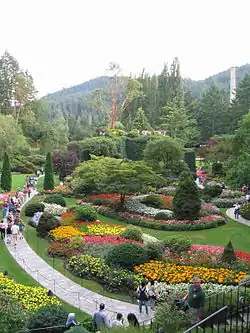 |
| Chee Kung Tong Building[16] | 1877 (completed) | 2008 | Barkerville 53°3′59.97″N 121°31′0.07″W |
A two-storey board and batten structure originally used by the Chee Kung Tong organization, a benevolent association for recent arrivals; illustrates the community building among immigrant Chinese labourers and merchants in new settlements throughout Canada |  |
| Chilkoot Trail |
1896-1900 (gold rush) | 1987 | Bennett 59°46′3.09″N 135°6′46.63″W |
A traditional transportation route through the Coast Mountains, connecting the upper Yukon River in B.C. with the Taiya Inlet in Alaska; famous as the route used by thousands of prospectors during the Klondike Gold Rush | 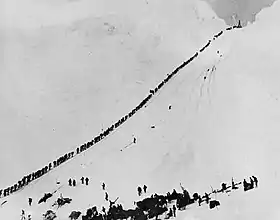 |
| Chilliwack City Hall[18] | 1912 (completed) | 1984 | Chilliwack 49°10′8.4″N 121°57′23.88″W |
A small Beaux-Arts style building that served as city hall until 1980; a monument to civic pride at the time of its construction, it is the only pre-1930 town hall in Canada constructed entirely of reinforced concrete |  |
| Chinese Cemetery at Harling Point[19] | 1903 (established) | 1995 | Oak Bay 48°24′24.09″N 123°19′23″W |
A cemetery on the shore of the Strait of Juan de Fuca with the largest concentration of pre-1950 Chinese mortuary features in Canada; a memorial to Chinese-Canadian pioneer immigrants |  |
| Christ Church[20] | 1861 (completed) | 1994 | Hope 49°22′51.69″N 121°26′38.85″W |
A wooden Anglican parish church in the Gothic Revival style built at the height of the Gold Rush era; the oldest church in British Columbia on its original foundation |  |
| Church of Our Lord[21] | 1875 (completed) | 1990 | Victoria 48°25′14.03″N 123°21′51.55″W |
A Reformed Episcopal church designed by John Teague; it is one of the finest examples of Carpenter Gothic on the west coast of Canada | 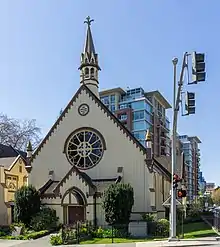 |
| Church of the Holy Cross[22] | 1906 (completed) | 1981 | Skookumchuck Hot Springs 49°56′19.06″N 122°24′23.68″W |
Renowned example of a Carpenter Gothic mission church, built by In-SHUCK-ch craftsmen; its distinctive profile renders it a landmark in the Skatin First Nation community |  |
| Congregation Emanu-El[23] | 1863 (completed) | 1979 | Victoria 48°25′39″N 123°21′40.93″W |
A two-storey brick synagogue constructed just 5 years after the arrival of the first Jewish settlers in B.C. in 1858; the oldest surviving synagogue in Canada, and a rare surviving example of a Romanesque Revival style synagogue in this country |  |
| Craigdarroch Castle[24] | 1890 (completed) | 1992 | Victoria 48°25′21.31″N 123°20′37.33″W |
A mansion of Scottish Baronial design located on a hill overlooking downtown Victoria; built to assert the wealth and stature of the industrialist Robert Dunsmuir, it is a noted example of an eclectic mansion in the west |  |
| Craigflower Manor House[25] | 1856 (completed) | 1964 | View Royal 48°27′9.54″N 123°25′17.82″W |
A timber-frame building built for the Puget Sound Agricultural Company; one of the key buildings of Craigflower Farm, one of Western Canada's first farming communities and symbolic of the region's transition from the fur trade to settlement |  |
| Craigflower Schoolhouse[26] | 1855 (completed) | 1964 | View Royal 48°27′9.54″N 123°25′17.82″W |
Built to serve children from Craigflower Farm and nearby settlements, the schoolhouse has been preserved virtually intact and is the oldest surviving school building in Western Canada |  |
| Dominion Astrophysical Observatory[27] | 1918 (completed) | 2001 | Saanich 48°31′11.26″N 123°25′4.9″W |
An observatory clad in painted white metal panels and featuring classically inspired architectural embellishments; it is a world-renowned facility where many discoveries about the nature of the Milky Way were made, and it was one of the world's main astrophysical research centres until the 1960s |  |
| Doukhobor Suspension Bridge[28] | 1913 (completed) | 1995 | Castlegar 49°19′3.05″N 117°37′46.89″W |
A suspension bridge that spans the Kootenay River, built by the Doukhobours; a symbol of Doukhobour culture and one of the few remaining pre-Second World War built resources connected with this group | 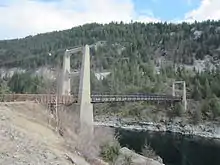 |
| Emily Carr House[29] | 1864 (completed) | 1964 | Victoria 48°24′49.68″N 123°22′12″W |
A two-storey Picturesque-Italianate style house; associated with Emily Carr, who was born in this house |  |
| Empress Hotel[30] | 1908 (initially completed) | 1981 | Victoria 48°25′18.66″N 123°22′4.69″W |
A nationally significant Château-style hotel, built for the Canadian Pacific Railway | .jpg.webp) |
| Esquimalt and Nanaimo Railway Roundhouse[31] | 1913 (completed) | 1992 | Victoria 48°25′47.74″N 123°22′52.42″W |
A roundhouse surrounded by railway shops and outbuildings; virtually unchanged since its construction, it is representative of the steam railway era in Canada | |
| Esquimalt Naval Sites[32] | 1865 (established) | 1995 | Esquimalt 48°25′56.19″N 123°25′54.57″W |
Four sites at the heart of CFB Esquimalt: Her Majesty's Canadian (HMC) Dockyard, the former Royal Navy Hospital, the Veterans’ Cemetery and the Cole Island Magazine; illustrative of years of naval history, from the era of the British Royal Navy to the modern Royal Canadian Navy |  |
| Estate of the Lieutenant Governor of British Columbia[33] | 1865 (Vice Regal use established); 1959 (house completed) | 2002 | Victoria 48°25′6.47″N 123°20′32.76″W |
A 14.6-hectare (36-acre) cultural landscape serving as the residence of the Governors and Lieutenant Governors of the province since 1865 | 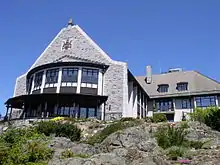 |
| First Crossing of North America[34] | 1793 (arrival of Mackenzie) | 1924 | Bella Coola 52°22′43″N 127°28′14″W |
Located in Sir Alexander Mackenzie Provincial Park, the site of the farthest point west reached by Alexander Mackenzie during the first journey across the continent of North America north of Mexico |  |
| Fisgard Lighthouse |
1860 (completed) | 1958 | Colwood 48°25′49.4″N 123°26′51.27″W |
The first permanent lighthouse on the Pacific coast of Canada, built to mark the entrance to Esquimalt Harbour |  |
| Former Vancouver Law Courts[36] | 1911 (completed) | 1980 | Vancouver 49°16′58.35″N 123°7′13.67″W |
Landmark courthouse that serves as an enduring symbol of the justice system in British Columbia, now used as the Vancouver Art Gallery; representative of the rapid growth and optimism of Vancouver at the time of its construction |  |
| Former Victoria Law Courts[37] | 1888 (completed) | 1981 | Victoria 48°25′33.6″N 123°22′7.68″W |
The first major public building constructed by the provincial government after union with Canada, built to house the Supreme Court of British Columbia; previously served as the home of the Maritime Museum of BC; now standing empty and in need of significant repairs. |  |
| Fort Alexandria[38] | 1821 (established) | 1925 | Alexandria 52°37′58.8″N 122°27′0″W |
Established as a trading post by the North West Company, it was the last post the company would build before its merger with the Hudson's Bay Company; there are no known above ground remains of the fort |  |
| Fort Hope[39] | 1848 (established) | 1927 | Hope 49°22′42.54″N 121°26′39.51″W |
Site of a Hudson's Bay Company post | |
| Fort Kamloops[40] | 1812 (first fort established) | 1924 | Kamloops | Site of North West Company and Hudson's Bay Company posts | |
| Fort Langley |
1839 (established) | 1923 | Fort Langley 49°10′5.16″N 122°34′17.76″W |
The site of a Hudson's Bay Company post located on the south banks of the Fraser River; the colony of British Columbia was proclaimed at Langley in 1858 |  |
| Fort McLeod[42] | 1805 (established) | 1953 | McLeod Lake 54°59′5″N 123°2′43″W |
The site of the first fur-trading post built by the North West Company west of the Rocky Mountains; for two decades after it was built, the fort served as the only liaison between the two sides of the Rockies | .jpg.webp) |
| Fort Rodd Hill |
1898 (established) | 1958 | Colwood 48°25′56.67″N 123°27′0.42″W |
A coastal defence site containing three artillery batteries; representative of the role of the Esquimalt Harbour fortifications in the defence of the British Empire and Canada |  |
| Fort St. James |
1806 (established) | 1948 | Fort St. James 54°26′6.19″N 124°15′25.67″W |
A restored fur trade post on Stuart Lake, founded by Simon Fraser; from 1826 to 1862 it was the headquarters of the Hudson's Bay Company's New Caledonia District |  |
| Fort St. John[45] | 1806 (established) | 1958 | Fort St. John 56°12′8.84″N 120°49′33.93″W |
Site of fur trade posts established by the North West Company | |
| Fort Steele[46] | 1887 (established) | 1925 | Fort Steele 49°37′0″N 115°38′0″W |
The first North West Mounted Police post in British Columbia, founded by Superintendent Sam Steele |  |
| Fort Victoria[47] | 1843 (established) | 1924 | Victoria 48°25′32.84″N 123°22′6.64″W |
Founded by the Hudson's Bay Company, the post became the centre of trade for British territory west of the Rockies; location of the first meeting of the Legislative Assembly of Vancouver Island |  |
| Gastown Historic District[48] | 1867 (established) | 2009 | Vancouver 49°17′3.56″N 123°6′31.8″W |
Historic commercial district comprising buildings built mostly between 1886 and 1914; an early Western Canadian city core preserved through the emergence of activist heritage movements in Canada in the early 1970s | 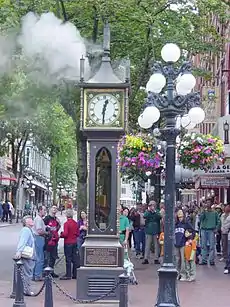 |
| Gitwangak Battle Hill (Kitwanga Fort) |
1867 (established) | 1971 | Kitwanga 55°7′16.27″N 128°1′5.26″W |
Remnants of a fortified Gitwangak village, located on the Kitwanga River, associated with legends which recall the epic battles of the warrior Nekt |  |
| Gulf of Georgia Cannery |
1894 (established) | 1976 | Steveston 49°7′29.89″N 123°11′12.17″W |
A complex of wooden buildings on a wharf that were used for fish processing and canning, located in what was historically the most important fishing village on the West Coast; illustrative of the development of the fish industry |  |
| Hatley Park / Former Royal Roads Military College[51] | 1913 (completed) | 1995 | Colwood 48°26′3.48″N 123°28′20.64″W |
A 229-hectare (570-acre) estate, with Hatley Castle, a Tudor Revival-style mansion, at the centre of an Edwardian landscape |  |
| Howse Pass[52] | 1807 (first European exploration) | 1978 | Blaeberry River and Banff National Park 51°48′53.53″N 116°46′20.31″W |
An early nineteenth-century transportation route through the Canadian Rockies |  |
| Kaslo Municipal Hall[53] | 1898 (completed) | 1984 | Kaslo 49°54′38.09″N 116°54′17.68″W |
A two-storey, wood-frame town hall with hip roof; the oldest remaining town hall on the British Columbia mainland | |
| Kicking Horse Pass |
1858 (first European exploration) | 1998 | Yoho National Park and Banff National Park 51°27′9.07″N 116°17′7.25″W |
A major rail and highway transportation corridor through the Rockies with some of the most spectacular mountain scenery in the world |  |
| Kiix?in Village and Fortress[55] | 1000 BCE (circa) (settlement) | 1971 | Barkley Sound 48°48′55″N 125°10′30″W |
A Huu-ay-aht village and fortress; it is the only known First Nations village on the British Columbia Coast that still features significant extant traditional architecture | |
| Kitselas Canyon[56] | 3000 BCE (circa) (settlement) | 1972 | Kitselas 54°36′00″N 128°26′00″W |
A canyon settled by Aboriginal peoples for approximately 5000 years; site of two Tsimshian 19th-century villages that controlled trade in the area |  |
| Kitwankul[57] | 1972 | Gitanyow 55°16′00″N 128°04′00″W |
Gitksan village, named Gitanyow since the 1990s |  | |
| Kiusta Village[58] | 1972 | Graham Island 54°10′38.3″N 133°1′30.95″W |
Former Haida village | ||
| Kootenae House |
1807 (completed) | 1934 | Invermere 50°31′35.85″N 116°2′43.58″W |
The archaeological site of a former North West Company post; the first trading post in the Columbia Basin, and David Thompson's base of exploration of the Columbia River | |
| Lions Gate Bridge[60] | 1938 (completed) | 2005 | Vancouver 49°18′55″N 123°8′18″W |
A landmark transportation link in Greater Vancouver; the longest suspension bridge in the British Empire when it was built |  |
| Malahat Building / Old Victoria Custom House[61] | 1875 (completed) | 1987 | Victoria 48°25′27.87″N 123°22′12.02″W |
A three-storey, mansard-roofed, custom house overlooking Victoria's harbour, symbolic of the time when Victoria was the pre-eminent commercial centre on Canada's West Coast | _-_06.JPG.webp) |
| Marpole Midden[62] | 1892 (excavation) | 1933 | Vancouver 49°12′18.92″N 123°8′16.74″W |
One of the largest pre-contact middens in Western Canada, containing the remains of a Coast Salish settlement |  |
| McLean Mill[63] | 1925 (established) | 1989 | Port Alberni 49°18′38.88″N 124°49′37.92″W |
A rare, surviving example of an early 20th-century sawmill and logging operation, located on a forested 13-hectare (32-acre) site in the Alberni Valley of Vancouver Island |  |
| Metlakatla Pass[64] | 1972 | Metlakatla 54°19′27.06″N 130°27′28.53″W |
Site on Pike Island at the western end of a narrow, protected ocean channel at the northern entrance to Prince Rupert Harbour; traditional location of the Northern Coast Tsimshian wintering villages | ||
| Miner's Union Hall[65] | 1898 (built) | June 20, 2019 | Rossland 49.076946°N 117.804491°W |
Gothic Revival building housed the first union mining local in BC, which fought for fair and safe working conditions, and won an eight-hour workday for BC miners | |
| Motor Vessel BCP 45[66] | 1927 (constructed) | 2005 | Campbell River 49°59′48.24″N 125°13′47.27″W |
Among the oldest and best preserved surviving examples of a wooden seiner, a type of fishing vessel intimately associated with the West Coast fishery and depicted on the Canadian five-dollar bill from 1972 to 1986 |  |
| Myra Canyon Section of the Kettle Valley Railway[67] | 1914 (completed) | 2002 | Central Okanagan 49°48′13.49″N 119°18′39.14″W |
A 9.6-kilometre (6.0 mi) section of railway roadbed comprising a series of high, steel and wooden trestles and tunnels; an outstanding engineering achievement which employed imaginative and ingenious solutions to routing and constructing a railway through mountainous terrain |  |
| Nan Sdins |
1981 | Gwaii Haanas 52°5′52.57″N 131°12′58.85″W |
Also known as Ninstints or SGang Gwaay Llanagaay, the remains of Haida longhouses and totem poles; a UNESCO World Heritage Site |  | |
| New Gold Harbour Area[69] | 1852 (circa) | 1972 | Gold Harbour | Site of Haida village | |
| Nikkei Internment Memorial Centre[70] | 1942 (internment camp), 1994 (memorial centre) | 2007 | New Denver 49°59′12″N 117°22′31″W |
A memorial centre on the shore of Slocan Lake, on the former site of an internment camp built to house forced Japanese Canadian evacuees from the West coast | 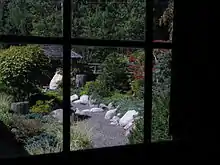 |
| North Pacific Cannery[71] | 1889 (established) | 1985 | Port Edward 54°11′40″N 130°13′28.94″W |
A salmon cannery located between the mountains and the Inverness Passage, comprising a relatively intact assemblage of structures representing over 100 years of the West Coast fishing industry |  |
| Orpheum Theatre[72] | 1927 (completed) | 1979 | Vancouver 49°16′48.35″N 123°7′12.71″W |
Known as the "Grand Old Lady of Granville", one of the few movie palaces in Canada to survive to present day in relatively unchanged condition |  |
| Pemberton Memorial Operating Room[73] | 1896 (completed) | 2005 | Victoria 48°25′58.17″N 123°19′39.39″W |
An octagonal brick operating room at Royal Jubilee Hospital; a rare surviving example of a surgical facility from the period when hospitals were transitioning from primarily charitable to scientific institutions |  |
| Point Atkinson Lighthouse[74] | 1912 (completed) | 2005 | West Vancouver 49°20′5″N 123°15′42″W |
A 18.3-metre (60 ft) high hexagonal lighthouse located across Burrard Inlet from Vancouver; an early example of its type |  |
| Point Ellice House / O'Reilly House[75] | 1864 (completed) | 1966 | Victoria 48°26′10.04″N 123°22′37.57″W |
A one-storey Victorian cottage that served as the home of Peter O'Reilly, a prominent colonial official; the cottage and its gardens represent one of the finest examples of the British Picturesque aesthetic in Canada | |
| Powell River Townsite Historic District[76] | 1911 (established) | 1995 | Powell River 49°52′21.44″N 124°32′53.35″W |
A residential neighbourhood of wood-frame houses built to house the workers of the nearby pulp and paper mill; a very well preserved example of a planned, single-industry town from the first half of the 20th century |  |
| Rogers Building[77] | 1903 (completed) | 1991 | Victoria 48°25′26.05″N 123°22′4.41″W |
A small Victorian era commercial building with a Queen Anne Revival shopfront, and intact interior fixtures and decorative features |  |
| Rogers Pass |
1881 (discovery by CPR) | 1971 | Glacier National Park 51°18′05″N 117°31′12″W |
A Canadian Pacific Railway route through Selkirk Mountains, instrumental in the development of the main line of the Canadian Pacific Railway into a major national transportation route |  |
| Rossland Court House[79] | 1901 (completed) | 1980 | Rossland 49°4′37.73″N 117°47′44.37″W |
A landmark buff brick building located on a steep slope with a commanding view over the surrounding area; representative of a distinctive regional form of Canadian courthouse that emerged in British Columbia in the late 19th century | _(cropped).jpg.webp) |
| Royal Theatre[80] | 1913 (completed) | 1987 | Victoria 48°25′23.64″N 123°21′44.21″W |
Built by the Victoria Opera House Company, the theatre served as a venue for dramatic, musical and vaudeville performances, and ultimately cinema; restored to live theatre in 1972, it is one of the finest surviving large-scale legitimate theatres in Canada | |
| SS Moyie[81] | 1898 (built) | 1958 | Kaslo 49°54′42.12″N 116°54′8.28″W |
A late 19th-century, steam-propelled paddle steamer, dry docked since 1958 on the shore of Kootenay Lake; at retirement she was the oldest Canadian-built paddle wheeler in service | _at_Kaslo_2008.jpg.webp) |
| Saint Paul's Roman Catholic Church[82] | 1884 (completed), 1909 (remodelled) | 1980 | North Vancouver 49°18′57.21″N 123°5′16.97″W |
A twin-spired, Gothic Revival church located in Eslha7an (the Mission Reserve); the oldest surviving mission church in the Vancouver area |  |
| Similkameen Spirit Trail[83] | 2007 | Hedley 49°24′7.18″N 120°15′29.2″W |
A cultural landscape illustrating over 4000 years of Upper Similkameen history, consisting of three sites linked by an aboriginal trail route: the Tulameen Ochre Bluffs, the Chuchuwayha Rock Shelter, and a series of 27 pictograph sites |  | |
| Skedans[84] | 1986 | Gwaii Haanas 52°57′52″N 131°36′29″W |
Former Haida village |  | |
| St. Andrew's Roman Catholic Cathedral[85] | 1892 (completed) | 1990 | Victoria 48°25′31.5″N 123°21′46.3″W |
An imposing twin-towered landmark in Victoria's urban core and an excellent representative example of the Gothic Revival style |  |
| St Ann's Academy[86] | 1871 (completed) | 1989 | Victoria 48°25′8.3″N 123°21′48.95″W |
A monumental brick building that served for more than a century as an important educational institute in Western Canada |  |
| St. Roch[87] | 1928 (constructed) | 1962 | Vancouver 49°16′38.94″N 123°8′49.95″W |
St. Roch is a restored auxiliary Royal Canadian Mounted Police schooner drydocked at the Vancouver Maritime Museum; the first ship to cross from the Pacific to the Atlantic by the Northwest Passage |  |
| Stanley Park |
1888 (established) | 1988 | Vancouver 49°18′00″N 123°8′24″W |
404.9-hectare (1,001-acre) public park on a peninsula that formerly served as a First Nations ceremonial site and as a British military reserve; epitome of the large urban park in Canada |  |
| Stave Falls Hydro-Electric Installation[89] | 1912 (completed) | 2003 | Mission 49°13′44.12″N 122°21′22.33″W |
A well-preserved example of a typical hydro-electric plant of the early 20th century, the core period of hydro-electric technological development, composed of three dams, a powerhouse, a switchyard and associated equipment |  |
| Tanu[90] | 1735 (circa) (settlement) | 1986 | New Clew 53°01′30″N 131°46′30″W |
Former Haida village in Gwaii Haanas National Park Reserve |  |
| Triple Island Lighthouse[91] | 1920 (completed) | 1974 | Triple Island 54°15′48″N 130°49′29″W |
An octagonal lighthouse on a rocky islet; the prevailing gales and high flood tides made its construction one of the most hazardous tasks in Canadian maritime history | |
| Tse'K'wa[92] | from 12,500 to 1,000 years ago | August 23, 2019 | Fort St. John 56.272892°N 120.944396°W |
archeological site at a place also called Charlie Lake Cave | |
| Twin Falls Tea House |
1910 (completion of first phase) | 1992 | Yoho National Park 51°32′35″N 116°31′39″W |
A log structure serving as a resting place for hikers; symbolic of outdoor recreation in the national parks and representative of the rustic design tradition |  |
| Union Club of British Columbia[94] | 1879 (established), 1913 (clubhouse) | 2016 | Victoria 48.422870°N 123.367180°W |
An early gentlemen's club's elegant Beaux-Arts clubhouse |  |
| Uplands[95] | 1908 | August 23, 2019 | Oak Bay 48.4485°N 123.3051°W |
Early garden subdivision preserves Native American archeology | |
| Vancouver Japanese Language School[96] | 1928 (built) | June 20, 2019 | Vancouver 49.284244°N 123.093631°W |
First and largest Japanese language school in the country. Significant for its return to Japanese owners after internment. |  |
| Vancouver's Chinatown[97] | 1880 (established) | 2011 | Vancouver 49°16′48″N 123°5′58″W |
One of the oldest and largest Chinatowns in the Canada; characterized by a distinctive "recessed balcony" style of architecture | 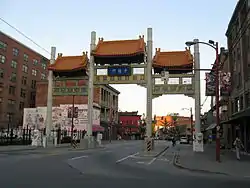 |
| Victoria City Hall[98] | 1890 (completed) | 1977 | Victoria 48°25′42″N 123°21′53.46″W |
One of the best surviving examples of Second Empire-style public architecture in western Canada |  |
| Victoria's Chinatown[99] | 1858 (established) | 1995 | Victoria 48°25′45.71″N 123°22′4.47″W |
The oldest surviving Chinatown in Canada; retains a cohesive assemblage of heritage structures and is dominated by its historical buildings |  |
| Vogue Theatre[100] | 1941 (completed) | 1993 | Vancouver 49°16′47.38″N 123°7′18″W |
A theatre designed to accommodate both cinema and live performance; a noted and well-preserved example of the Streamline Moderne style in Canada |  |
| Weir's (Taylor's) Beach Earthworks Site[101] | 1974 | Metchosin 48°22′55.28″N 123°32′16.66″W |
Pre-contact earthworks on Vancouver Island | ||
| Whaler's Shrine Site[102] | 1983 | Yuquot 49°35′28.63″N 126°36′59.84″W |
Original site of the most significant monument associated with Nuu-chah-nulth whaling; the shrine was dismantled by an anthropologist in 1905 and presently resides at the American Museum of Natural History |  | |
| Xá:ytem / Hatzic Rock[103] | 3000 BCE (circa) | 1992 | Mission 49°9′6.55″N 122°15′1.56″W |
Habitation site of Stó:lo peoples | 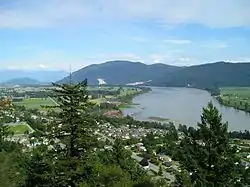 |
| Yan Village Indian Site[104] | 1972 | Masset 54°3′49.39″N 132°14′22.25″W |
Former Haida village | ||
| Yuquot[105] | 1923 | Yuquot 49°36′N 126°37′W |
Centre of the social, political and economic world of the Mowachaht/Muchalaht First Nations, and the first point of contact between Europeans and an indigenous people of the west coast of Canada; location of signing of the Nootka Conventions |  | |
See also
| Wikimedia Commons has media related to National Historic Sites of Canada in British Columbia. |
External links
- National Historic Sites of Canada - Parks Canada
- Historic places - Administered by Parks Canada
References
- Directory of Federal Heritage Designations - British Columbia, Parks Canada
- British Columbia Archived 2012-10-06 at the Wayback Machine, National Historic Sites of Canada - administered by Parks Canada
- Federal plaque to John Macdonell on Ontarioplaques.com
- Glengarry House NHS in Directory of Federal Heritage Designations (DFHD)
- Landing of John Guy NHE in DFHD
- 223 Robert Street. Canadian Register of Historic Places. Retrieved 23 October 2011.
- Abbotsford Sikh Temple. Canadian Register of Historic Places. Retrieved 23 October 2011.
- Barkerville. Canadian Register of Historic Places. Retrieved 23 October 2011.
- Bay Street Drill Hall. Canadian Register of Historic Places. Retrieved 23 October 2011.
- Begbie Hall. Canadian Register of Historic Places. Retrieved 23 October 2011.
- Binning Residence. Canadian Register of Historic Places. Retrieved 23 October 2011.
- Boat Encampment. Canadian Register of Historic Places. Retrieved 23 October 2011.
- Britannia Mines Concentrator. Canadian Register of Historic Places. Retrieved 24 October 2011.
- Britannia Shipyard. Canadian Register of Historic Places. Retrieved 24 October 2011.
- Butchart Gardens. Canadian Register of Historic Places. Retrieved 24 October 2011.
- Chee Kung Tong Building. Canadian Register of Historic Places. Retrieved 29 October 2011.
- Chilkoot Trail. Canadian Register of Historic Places. Retrieved 29 October 2011.
- Chilliwack City Hall. Canadian Register of Historic Places. Retrieved 29 October 2011.
- Chinese Cemetery at Harling Point. Canadian Register of Historic Places. Retrieved 29 October 2011.
- Christ Church. Canadian Register of Historic Places. Retrieved 29 October 2011.
- Church of Our Lord. Canadian Register of Historic Places. Retrieved 30 October 2011.
- Church of the Holy Cross. Canadian Register of Historic Places. Retrieved 30 October 2011.
- Congregation Emanu-El. Canadian Register of Historic Places. Retrieved 30 October 2011.
- Craigdarroch Castle. Canadian Register of Historic Places. Retrieved 30 October 2011.
- Craigflower Manor House. Canadian Register of Historic Places. Retrieved 13 November 2011.
- Craigflower Schoolhouse. Canadian Register of Historic Places. Retrieved 13 November 2011.
- Dominion Astrophysical Observatory. Canadian Register of Historic Places. Retrieved 13 November 2011.
- Doukhobor Suspension Bridgey. Canadian Register of Historic Places. Retrieved 13 November 2011.
- Emily Carr House. Canadian Register of Historic Places. Retrieved 13 November 2011.
- Empress Hotel. Canadian Register of Historic Places. Retrieved 13 November 2011.
- Esquimalt and Nanaimo Railway Roundhouse. Canadian Register of Historic Places. Retrieved 21 November 2011.
- Esquimalt Naval Sites. Canadian Register of Historic Places. Retrieved 21 November 2011.
- Estate of the Lieutenant Governor of British Columbia. Canadian Register of Historic Places. Retrieved 23 November 2011.
- First Crossing of North America. Canadian Register of Historic Places. Retrieved 23 November 2011.
- Fisgard Lighthouse. Canadian Register of Historic Places. Retrieved 25 November 2011.
- Former Vancouver Law Courts. Canadian Register of Historic Places. Retrieved 25 November 2011.
- Former Victoria Law Courts. Canadian Register of Historic Places. Retrieved 26 November 2011.
- Fort Alexandria. Canadian Register of Historic Places. Retrieved 26 November 2011.
- "Fort Hope National Historic Site of Canada". Directory of Designations of National Historic Significance of Canada. Parks Canada. Retrieved 27 November 2011.
- "Fort Kamloops National Historic Site of Canada". Directory of Designations of National Historic Significance of Canada. Parks Canada. Retrieved 27 November 2011.
- Fort Langley. Canadian Register of Historic Places. Retrieved 27 November 2011.
- Fort McLeod. Canadian Register of Historic Places. Retrieved 27 November 2011.
- Fort Rodd Hill. Canadian Register of Historic Places. Retrieved 30 November 2011.
- Fort St. James. Canadian Register of Historic Places. Retrieved 8 January 2012.
- "Fort St. John National Historic Site of Canada". Directory of Designations of National Historic Significance of Canada. Parks Canada. Retrieved 8 January 2012.
- Fort Steele. Canadian Register of Historic Places. Retrieved 8 January 2012.
- Fort Victoria. Canadian Register of Historic Places. Retrieved 20 January 2012.
- Gastown Historic District. Canadian Register of Historic Places. Retrieved 21 January 2012.
- Gitwangak Battle Hill. Canadian Register of Historic Places. Retrieved 21 January 2012.
- Gulf of Georgia Cannery. Canadian Register of Historic Places. Retrieved 21 January 2012.
- Hatley Park / Former Royal Roads Military College. Canadian Register of Historic Places. Retrieved 22 January 2012.
- Howse Pass. Canadian Register of Historic Places. Retrieved 22 January 2012.
- Kaslo Municipal Hall. Canadian Register of Historic Places. Retrieved 22 January 2012.
- Kicking Horse Pass. Canadian Register of Historic Places. Retrieved 22 January 2012.
- Kiix?in Village and Fortress. Canadian Register of Historic Places. Retrieved 22 January 2012.
- Kitselas Canyon. Canadian Register of Historic Places. Retrieved 22 January 2012.
- Kitwankul National Historic Site of Canada. Directory of Federal Heritage Designations. Parks Canada. Retrieved 12 March 2013.
- "Kiusta Village National Historic Site of Canada". Directory of Designations of National Historic Significance of Canada. Parks Canada. Retrieved 22 January 2012.
- Kootenae House. Canadian Register of Historic Places. Retrieved 22 January 2012.
- Lions Gate Bridge. Canadian Register of Historic Places. Retrieved 22 January 2012.
- Malahat Building / Old Victoria Custom House. Canadian Register of Historic Places. Retrieved 24 January 2012.
- Marpole Midden. Canadian Register of Historic Places. Retrieved 24 January 2012.
- McLean Mill. Canadian Register of Historic Places. Retrieved 24 January 2012.
- Metlakatla Pass. Canadian Register of Historic Places. Retrieved 28 January 2012.
- Canada Announces New National Historic Designations, Parks Canada news release, June 20, 2019
- Metlakatla Pass. Canadian Register of Historic Places. Retrieved 28 January 2012.
- Myra Canyon Section of the Kettle Valley Railway. Canadian Register of Historic Places. Retrieved 28 January 2012.
- "Nan Sdins National Historic Site of Canada". Directory of Designations of National Historic Significance of Canada. Parks Canada. Retrieved 28 January 2012.
- "New Gold Harbour Area National Historic Site of Canada". Directory of Designations of National Historic Significance of Canada. Parks Canada. Retrieved 21 January 2012.
- Nikkei Internment Memorial Centre. Canadian Register of Historic Places. Retrieved 28 January 2012.
- North Pacific Cannery. Canadian Register of Historic Places. Retrieved 28 January 2012.
- Orpheum Theatre. Canadian Register of Historic Places. Retrieved 28 January 2012.
- Pemberton Memorial Operating Room. Canadian Register of Historic Places. Retrieved 28 January 2012.
- Point Atkinson Lighthouse. Canadian Register of Historic Places. Retrieved 28 January 2012.
- Point Ellice House / O'Reilly House. Canadian Register of Historic Places. Retrieved 28 January 2012.
- Powell River Townsite Historic District. Canadian Register of Historic Places. Retrieved 28 January 2012.
- Rogers Building. Canadian Register of Historic Places. Retrieved 28 January 2012.
- Rogers Pass. Canadian Register of Historic Places. Retrieved 28 January 2012.
- Rossland Court House. Canadian Register of Historic Places. Retrieved 29 January 2012.
- Royal Theatre. Canadian Register of Historic Places. Retrieved 29 January 2012.
- S.S. Moyie. Canadian Register of Historic Places. Retrieved 29 January 2012.
- Saint Paul's Roman Catholic Church. Canadian Register of Historic Places. Retrieved 29 January 2012.
- Similkameen Spirit Trail. Canadian Register of Historic Places. Retrieved 29 January 2012.
- "Skedans National Historic Site of Canada". Directory of Designations of National Historic Significance of Canada. Parks Canada. Retrieved 29 January 2012.
- St. Andrew's Roman Catholic Cathedral. Canadian Register of Historic Places. Retrieved 29 January 2012.
- St Ann's Academy. Canadian Register of Historic Places. Retrieved 30 January 2012.
- St. Roch. Canadian Register of Historic Places. Retrieved 30 January 2012.
- Stanley Park. Canadian Register of Historic Places. Retrieved 31 January 2012.
- Stave Falls Hydro-Electric Installation. Canadian Register of Historic Places. Retrieved 1 February 2012.
- "Tanu National Historic Site of Canada". Directory of Designations of National Historic Significance of Canada. Parks Canada. Retrieved 1 February 2012.
- Triple Island Lighthouse. Canadian Register of Historic Places. Retrieved 2 February 2012.
- Government of Canada Announces Seven National Historic Designations, Parks Canada news release, August 23, 2019
- Twin Falls Tea House. Canadian Register of Historic Places. Retrieved 2 February 2012.
- The Union Club of British Columbia, Parks Canada backgrounder, July 4, 2016
- Government of Canada Announces Seven National Historic Designations, Parks Canada news release, August 23, 2019
- Canada Announces New National Historic Designations, Parks Canada news release, June 20, 2019
- Vancouver's Chinatown. Directory of Federal Heritage Designations. Parks Canada. Retrieved 4 May 2012.
- Victoria City Hall. Canadian Register of Historic Places. Retrieved 4 February 2012.
- Victoria's Chinatown. Canadian Register of Historic Places. Retrieved 4 February 2012.
- Vogue Theatre. Canadian Register of Historic Places. Retrieved 4 February 2012.
- "Weir's (Taylor's) Beach Earthworks Site National Historic Site of Canada". Directory of Designations of National Historic Significance of Canada. Parks Canada. Retrieved 5 February 2012.
- Whaler's Shrine Site. Canadian Register of Historic Places. Retrieved 5 February 2012.
- Xá:ytem / Hatzic Rock. Canadian Register of Historic Places. Retrieved 5 February 2012.
- "Yan Village Indian Site National Historic Site of Canada". Directory of Designations of National Historic Significance of Canada. Parks Canada. Retrieved 5 February 2012.
- Yuquot. Canadian Register of Historic Places. Retrieved 5 February 2012.